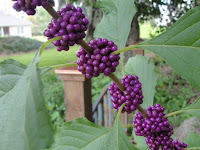As we make our gardens more attractive to wildlife we provide our local fauna with the necessary elements for their survival as more and more of their habitat is destroyed by development. In return, we reap enormous benefits by attracting a wide variety of butterflies, birds, insects, reptiles and other native animals to our gardens.
Sharing my garden with an abundance of beautiful creatures is personally rewarding to me and proof that we can make a difference in our little part of the world when we tweak our gardens with the intention of inviting a variety of wildlife in.
It's easy to adapt our yards to accomodate and attract wildlife. In the next 5 posts we'll look at simple steps you can take to make your garden more wildlife friendly.
The FIRST element necessary to attract wildlife is to provide a variety of food sources.
TO-DO: Add a variety of native and Florida-friendly plants that produce seeds, fruits, nuts, berries and nectar. Some of the most popular and easy to find items on the menu for central Florida wildlife are:
Seeds & Nuts: Amaranth Amaranthus spp., Zinnia Zinnia spp., Crape myrtles Lagerstroemia indica, Sunflowers Helianthus spp., Scarlet Sage Salvia spp., Cleome Cleome hasslerana, Cosmos Cosmos bipinnatus, Wax Myrtles Myrica cerifera, Live Oaks Quercus virginiana.
Fruit: Mulberries, blackberries, blueberries, Coral honeysuckle vine Lonicera sempervirens.
Berries: Simpson Stoppers Myrcianthes fragrans, dahoon holly Ilex cassine, holly shrubs Ilex spp., American beautyberry Callicarpa americana, Wild coffee Psychotria spp., Privet Ligustrum spp., Sabal palm Sabal palmetto, Firebush Hamelia patens.
Nectar: Bottlebrush Callistemon spp., Golden dewdrop Duranta repens, Firebush Hamelia patens, Louis Phillippe rose, Shrimp plant Justicia brandegeana, Lantanas, Firespike Odontonema strictum, Pentas Pentas lanceolata, Coral honeysuckle Lonicera sempervirens, Trumpet vine Campsis radicans, Purple coneflower Echinacea coelestinum, Milkweed Asclepias spp., Agastache , Indian Blanket flower Gaillardia pulchella, Plumbago Plumbago auriculata, Asters (native), Sunflower Helianthus spp. Impatiens Impatiens wallerana, Zinnias Zinnia spp., Stokes' Aster Stokesia laevis, Salvia varieties, Florida petunia Ruellia caroliniensis, Bee balm Monarda spp., Kalanchoes Kalanchoe spp. Daylily Hemerocallis spp., Beach sunflower Helianthus debilis, Aloe Aloe vera.
NOTE: It's okay to supplement food sources with bird seed or nectar in hummingbird feeders but you'll find that you'll attract and maintain more birds in your garden if you provide a more diverse year-round diet of pertinent plants. Plus, you'll save a few dollars on bird seed.
I have a number of feeders throughout my garden because I enjoy watching the birds who visit, but I've noticed that they frequent their favorite plants more often than the feeders which is great since I sometimes get too busy to keep them full.
Wildlife Friendly Tip:
Be a little less tidy in the garden by leaving seedheads on plants at the end of summer for the increased number of birds we enjoy in winter. I've noticed that titmice and wrens are busy all winter long eating seeds from my crepe myrtles, agastache and coneflowers. As you can see, getting started is easy. As you add new plants to your garden include some of the ones mentioned above and you'll be on your way to creating your very own wildlife habitat.

